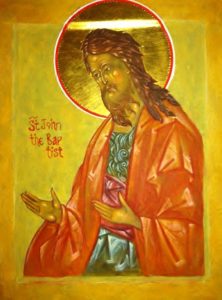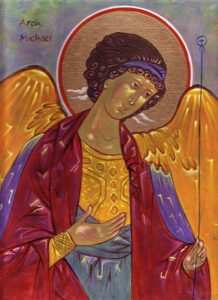Idolatry and Iconoclasm
Part One in the Series, The Image-less Idol: How Iconoclasm leads to Idolatry
Idolatry and Iconoclasm
When considering mankind’s relationship with images, all of history has been marred by a tendency towards extremes: idolatry on the one end, and iconoclasm on the other. Both extremes, idolatry and iconoclasm, find their genesis in Adam’s transgression and are interrelated. In Adam’s haste to “become like God, knowing good and evil (Genesis 3.5b),” both idolatry and iconoclasm were introduced into human history. Adam created an idol of the Tree of Knowledge of Good and Evil, choosing its fruit and the false promise of the Serpent over the true God whom he knew. As a consequence of his actions, Adam also became an iconoclast, breaking or marring the image of God within him.

This continual slide between idolatry and iconoclasm can be seen throughout the Bible as well as the history of the Church. This pendulous relationship with the image can be seen in the account of the Bronze Serpent. In the book of Numbers, as the Israelites were wandering the desert they began to grumble against God and Moses. In response, God sent fiery serpents to strike the people and many of them died. As a result, the remaining Israelites cried out to Moses in repentance saying, “We have sinned, for we have spoken against the Lord and against you (Numbers 21.7).” God then instructed Moses to make a bronze serpent, and place it up on a standard, so that when the people looked upon it, they would be healed. In this instance, a proper relationship to the image is evident. The Bronze Serpent is seen as a type and figure of the Crucifixion of Christ — a symbol of salvation. Those who look upon the cross are healed from the poison of sin which causes death to the soul much in the same way that the Bronze Serpent healed the bodies of those infected by the poison of the fiery serpents. “As Moses lifted up the serpent in the wilderness, even so must the Son of Man be lifted up; so that whoever believes will in Him have eternal life(John 3.14-15).”Unfortunately, this is not the end of the history of the Bronze Serpent.
Seven hundred years later, in the reign of King Hezekiah, Israel developed a different relationship with the image. They no longer saw the Bronze Serpent as a symbol of God’s mercy, an instrument of His healing, but looked upon it as a god. Having fallen into idolatry, King Hezekiah desired to purge the nation of Israel of its idolatrous influences. “He removed the high places, smashed the sacred stones and cut down the Asherah poles. He broke into pieces the bronze snake Moses had made, for up to that time the Israelites had been burning incense to it (Kings 18.4).” The relationship between mankind and the image had once again changed; whereas once the bronze serpent was seen as a symbol of God’s salvation, it became a god in itself, being offered worship by the Israelites. This caused Hezekiah to smash the image, to commit an act of iconoclasm.
Idolatry and Iconoclasm throughout History
This slide between the two poles of idolatry and iconoclasm can be be seen extending throughout history, and in many ways is still being repeated in the contemporary era. This push and pull between extremes reached its apex during the iconoclastic controversy of the eastern Church during the eighth and ninth centuries. This controversy would cause the Church to formulate a doctrine on the proper nature of man’s relationship to the image. At the Seventh Ecumenical Council, the Church would issue canons that would forge a middle way for the image, one that avoids both the extremes of iconoclasm and idolatry.

As often happens, from controversy springs intellectual flowering. This is certainly true of the iconoclastic struggle. While writings that both support and criticize the use of icons have existed since the founding of the church, it wasn’t until the imperial edict of AD 730, which banned the use of icons, and the persecution that followed, that the church sought to develop a philosophical, theological, and scriptural basis for the icon. It was in this environment of persecution, martyrdom, exile, and marginalization that an intellectual formulation of iconology, rooted in the historical and theological understanding of the nature of the Trinity, the Holy Scriptures, and their relationship to the image became debated and solidified. For the first time in history, a proper understanding of the image would be articulated, one that balanced out the two interrelated poles of idolatry and iconoclasm.
Iron Sharpens Iron – Controversy Forces the Church to Formalize Proper Doctrine
Luminaries such as St. John of Damascus, St. Theodore the Studite, and Patriarch Nicophoros among others, codified the diverse writings of the early church fathers and the Holy Scriptures and presented a unified argument in support of icons that made direct and effective appeal to the Incarnation and the natures of both God and Man; their argument was one steeped in the salvation history of mankind with relation to the work of God in Jesus Christ. “The defense of the icon was a defense of the Incarnation, and of the salvation of man.”(1)
The iconoclasts however, were not without a cogent defense of their position. The iconoclasts argued that icons where not only in violation of the Second Commandment which prohibited the creation of images, “Thou shalt not make unto thee any graven image, or any likeness ofany thing that is in heaven above, or that is in the earth beneath, or that is in the water under the earth (Exodus 20.4a),” but that icons also separated the dual natures of Christ, thus falling into the Monophysite, or the Nestorian heresy.(2) Neither heresy was theologically acceptable, and both had already been condemned by ecumenical church councils
The entire iconoclastic debate encouraged a more learned approach to theology because the defenders and the accusers of icons had to examine the patristic tradition in order to fashion their arguments. In the centuries that followed, the production of hymns, poems, sermons, chronicles, and memoirs increased significantly. Since it was accepted that the icon was as significant as the word, and since the written and hymnographic literature became more sophisticated, iconography had to assert itself in a more sophisticated way.(3)
Monasteries became important centers of learning during the iconoclastic period. Since the defeat of paganism, monastics shifted their focus to more spiritual disciplines without much thought for the intellectual, however, during the era of iconoclasm all of this would change. The “monks proved to be the sturdiest defenders of icons, but they had to turn to philosophy and the study of the Fathers to construct well-thought-out intellectual arguments to refute the accusations of the iconoclasts. Education and study found a new place and purpose within monastic activities.”(4)
Thus the iconoclastic controversy, much like the controversies regarding the nature of Christ which proceeded it, spurred an intellectual and philosophical fervor within the church as both schools of thought, iconoclast and iconodule, were forced to develop and present convincing proofs to support their understanding of the same church fathers, and the same Holy Scriptures. Since both schools cull their proofs from the historical sources, Holy Scripture and the early church fathers, it is important to begin with these in order to gain a proper understanding of the arguments.
Read the Next Articles in the Series on the Imageless Idol: How Iconoclasm leads to Idolatry
- Introduction: Icons and Idolatry
- Are Icons Idols? The Mosaic Prohibition
- Early Church Attitudes towards the Image: Icon or Idol?
- The War on Images Begins: The Icoloclastic Controversy
- Post-Iconoclastic Controversies
- Conclusion
References: Idolatry and iconoclasm
(1) Lossky, Vladamir & Ouspensky, Leonid, The Meaning of Icons, (Crestwood, NY: St. Vladimir’s Seminary Press, 1982), 34.
(2) Vrame, Anton, The Educating Icon (Brookline, MA: Holy Cross Press, 1999), 24.
(3) Andreopoulos, Andreas, Metamorphasis: The Transfiguration in Byzantine Theology and Iconography, (Crestwood, NY: St. Vladimir’s Seminary Press, 2005), 182.
(4) Andreopoulos, 183.

2 Replies to “Idolatry and Iconoclasm”